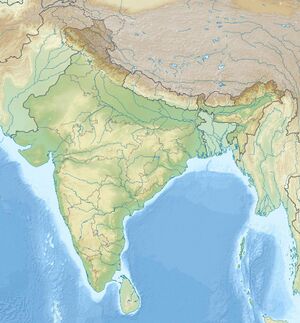Diamond mining in India
Topic: Chemistry
 From HandWiki - Reading time: 4 min
From HandWiki - Reading time: 4 min
Diamond mining in India extends back into antiquity. From ancient times, India was the source of nearly all the world's known diamonds, and until the discovery of diamonds in Brazil in 1726, India was the only place where diamonds were mined. India has not been a major diamond-producing country since the 1700s, but diamond mining continues. In 2013, India mined 37,515 carats of diamonds, from one industrial-scale mine and many artisanal mines; this was less than one-tenth of one percent of the world production of 132.9 million carats.[1]
History
Ancient times
Diamond mining as an industry appears to have originated between 800 and 600 B.C. in India.[2]
Accounts of early Indian diamond mining that reached Europe were often mixed with myths. Around 400 B.C., the Greek physician Ctesias published Indika, a compilation of travelers' tales about India (he himself had never been to India). He described incredibly rich diamond deposits guarded by griffins. Pliny the Elder, in his Natural History (79 A.D.), correctly described diamonds being washed from river gravel in India.
Medieval period (1200 to 1800 A.D.)
Diamonds were reported from numerous places across India, but most of the diamond mining took place by placer mining in the drainages of the Pennar and Krishna rivers in modern Andhra Pradesh state. Placer mining took place along the Krishna River for 300 km below Sangram. The most intensive mining was in a 60 km zone along the river, from the Kollur Mine to Paritala. This area was the source of many legendary gems, including the Koh-i-noor, Nizam, Hope, Regent, Great Mogul, and Orlov diamonds.[3]
India's unique status as a producer of diamonds continued to fascinate Europeans. Marco Polo traveled along the coast of India in 1292, and recorded tales he heard about diamonds being found in deep mountain valleys made nearly inaccessible by heat, lack of water, and venomous snakes.[4] The French traveler Jean Baptiste Tavernier visited the Krishna River diggings in 1665, and estimated that about 60,000 people were mining diamonds.
The town of Karwan, near the fortress city of Golkonda, now a suburb of Hyderabad, became the world's largest diamond-cutting and diamond-trading center. Golconda was not close to diamond mines, but owed its status as a diamond center to its location on a major trade route from the mines to the south and east. The diamonds became known as Golconda Diamonds, and in Europe, the word Golconda came to mean a place of great wealth.
India continued to be the world's leading source - and nearly the only source - of diamonds until diamonds were discovered in Brazil in 1726. At first, Brazilian diamonds were reputed to be inferior, and did not command as high a price as the Indian article. To obtain better prices, Portuguese traders began shipping Brazilian diamonds through Goa, and then to Europe to be sold as genuine Golconda diamonds. Indian diamond mining declined rapidly in the 1700s, due to a combination of exhaustion of known deposits and competition from Brazil.[5]
Diamond mining in the Panna region around 1675 AD was initiated during the rule of Chhatrasal, the Bundela ruler.[6]. Diamond mining has continued in Panna region.[7]
Recent mining in Panna region (Bundelkhand)
As of 2017, there was one industrial-scale diamond mine in India, the Majhgawan mine, near the town of Panna, Madhya Pradesh. The deposit is in a kimberlite or lamproite pipe 6.5 ha in area, and yields 10 carats to the ton. Mining is done by an open pit, which was 85 m deep as of 2011. Exploration drilling has established that the pipe continues down to at least 330 m.[8] The mine is owned by the National Mineral Development Corporation (NMDC), employs 199 people, and has a productive capacity of 84,000 carats per year. The mine began regular production in 1967, and to date, has yielded slightly more than a million carats of diamonds.[9]
There are also numerous artisanal-scale mines. In the Panna mining district, the Madhya Pradesh government leases 8x8m plots to individuals, who wash the gravel for diamonds. All diamonds found are required to be handed over to the government diamond office in Panna, which markets the gems, and gives the sales proceeds to the finders, less taxes and 11.5 percent royalty. In 2016, there were officially 952 artisanal mines, which yielded 835 carats of diamonds. However, there is an unknown number of small illegal mines, and an unknown amount of diamonds sold on the black market.[10]
The Rio Tinto Group discovered the Bunder diamond deposit in 2004 in Chhatarpur district near Buxwaha. The deposit is in an ecologically sensitive area. In February 2017, Rio Tinto quit work on the project, and gave the deposit and all on-site equipment to the state government of Madya Pradesh.[11]
See also
- Mining in India
Citations
- ↑ World Mineral Production 2009-2013, British Geological Survey.
- ↑ James Remington McCarthy, Fire in the Earth (New York: Harper, 1942) 21.
- ↑ Detailed Information Dossier on Diamond in India, 2011, India Geological Survey, p.22, 124.
- ↑ Marc Polo, The Travels of Marco Polo.
- ↑ James Remington McCarthy, Fire in the Earth (New York: Harper, 1942) 21.
- ↑ [https://books.google.com/books?id=fghQhiowlycC&pg=PA52&dq=panna+diamond+mining+chhatrasal&hl=en&sa=X&ved=0ahUKEwj_i4vD97rZAhWmyoMKHQA1DUgQ6AEISjAG#v=onepage&q=panna%20diamond%20mining%20chhatrasal&f=false Between History and Legend: Status and Power in Bundelkhand, Ravindra K. Jain, Orient Blackswan, 2002, p.52]
- ↑ PRESENT STATUS OF DIAMOND MINING INDUSTRY OF PANNA by R. K. MALVIYA, Diamond: A Collection of Papers Presented at the Symposium Held on 6th, 7th and 8th September, 1969 at Panna, Geological Survey of India, p. 196
- ↑ Detailed Information Dossier on Diamond in India, 2011, India Geological Survey, p.50-53.
- ↑ Diamond mining project, Panna, NMDC, accessed 28 Mar. 2017.
- ↑ Neeraj Santoshi, "Panna illegal mining rampant in India's only diamond-producing region", Hindustan Times, 27 Jan. 2017.
- ↑ Swansy Afonso, "Rio gifts India diamond mine to Madya Pradesh government", Bloomberg, 6 Feb. 2017.
 KSF
KSF
